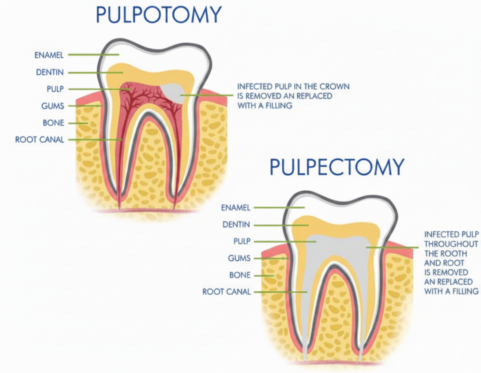Pulp Therapy

Our primary goal is to maintain the health of your child’s natural teeth. Inside every tooth is the “pulp,” which contains the nerves and blood vessels that keep the tooth alive and healthy.
When a tooth is affected by deep decay or a traumatic injury, this pulp can become infected or inflamed, causing pain and swelling. Pulp therapy is a specialized procedure used to treat the infected pulp, allowing us to save the tooth rather than extracting it.
Why is it Important to Save a Primary (Baby) Tooth?
A common question parents ask is: “Why treat a baby tooth if it’s eventually going to fall out?”
Saving a primary tooth is vital for several reasons:
-
Proper Development: Baby teeth act as “space maintainers,” guiding permanent teeth into the correct position.
-
Speech & Chewing: Healthy teeth are essential for clear speech development and proper nutrition through effective chewing.
-
Preventing Infection: Untreated pulp infections can lead to painful abscesses and may even damage the permanent teeth developing underneath.
Types of Pulp Therapy
Depending on the extent of the infection, our specialists will recommend one of two approaches:
-
Pulpotomy (Partial Removal): If the decay has only reached the top portion of the pulp, we remove the infected part, treat the remaining healthy pulp with a medicated material, and seal the tooth.
-
Pulpectomy (Full Removal): If the entire pulp is infected (similar to a standard root canal), we gently remove the pulp from both the crown and the roots. The canals are then cleaned, disinfected, and filled with a special resorbable material.
What to Expect During the Procedure
We understand that any dental procedure can be stressful for a child. At Dr. Dina’s, we prioritize your child’s comfort:
-
Gentle Care: We use local anesthesia to ensure the area is completely numb.
-
Comfort Options: For children who are anxious, we offer Conscious Sedation to help them feel relaxed and safe throughout the visit.
-
Restoration: After pulp therapy, the tooth is usually weakened. We typically recommend a dental crown (such as a stainless steel or white zirconia crown) to restore the tooth’s strength and function until it naturally falls out.
Signs Your Child May Need Pulp Therapy
If your child experiences any of the following, please contact us for an evaluation:
-
Constant or unexplained tooth pain.
-
Sensitivity to hot or cold temperatures.
-
Swelling or redness around the gums.
-
Unexpected loosening of a tooth.
